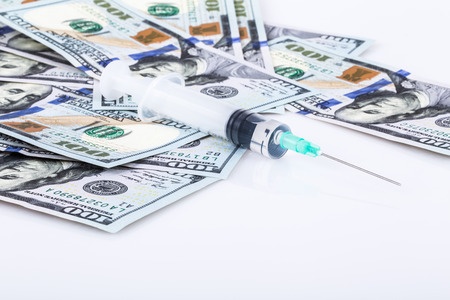
I live in the suburbs of Pittsburgh. At least nine times each week I drive past a retail store where someone I know once told me they shot up heroin in the store’s parking lot. The store sits on a busy street. This incident was a few years ago, but I’m pretty sure that wasn’t the only time someone used heroin in my neighborhood, because it’s happening all around me.
A teacher from the Montour School District was recently charged with two counts of possession with intent to deliver. Police said he was selling heroin out of his home. The school district suspended him immediately. The school district’s solicitor said there was no evidence that the man possessed or sold drugs on school property. The accused has been a math teacher for at least a decade. The ironic twist is that he rented his home from the Robinson Township police chief, who said he’s never had any problems with the accused … until now.
The Pittsburgh Post-Gazette reported at the end of February 2015 that three people from Armstrong County were charged in connection with an overdose death linked to fentanyl-laced heroin known as “theraflu.” I work part time at an outpatient treatment center in Pittsburgh and remember when the theraflu scare was going on in January last year. Seventeen people from around Pittsburgh died of overdoses in a week. A local medical examiner at the time said it was “major public health crisis.”
An ongoing investigation of drug trafficking in Homewood and other communities in the Pittsburgh metro area recently added 14 new defendants to the 40 who were originally indicted in October of 2014. US Attorney David Hickton said they were “important cogs” in a multi-state drug distribution ring. “They would be the Pittsburgh connection to this organization that has reach far beyond out state.” The trafficking involved heroin, cocaine and crack cocaine coming from Los Angles to Homewood via Cleveland. Harold Hayes of KDKA said: “The FBI says the long-term investigation has led to the indictment of more than 100 people and the seizure of more than $1 million.”
The 2014 National Drug Threat Assessment Summary (NDTS) published by the DEA stated that the threat posed by heroin in the US has been increasing across the country, particularly in the Northeast and North Central regions. The two major geographic areas for heroin supply in the US are Mexico and South America. Together they account for 96% of the heroin analyzed by the DEA in 2012. The NDTS reported that heroin seizures increased 87 percent in five years, from 2009 to 2013.
The observed increase in demand for and abuse of heroin is said to be the result of individuals who used to abuse prescription opioids switching to heroin. Reasons given for the switch include: the relatively lower cost of heroin than prescription opioids; the decreasing availability of prescription opioids versus the increasing availability of heroin; the reformulation of OxyContin, making it more difficult to abuse. My own experience with people abusing heroin is that the switch is mostly market driven, by the cost differential and the availability of heroin.
In 2013 and 2014, the Northeast and Midwest reported a spike in overdose deaths from fentanyl being sold as heroin. Fentanyl is 30 to 50 times stronger than heroin. The overdoses include both new and experienced users. Thinking they are buying heroin, the users typically don’t realize they are buying fentanyl or a fentanyl-heroin mixture. Between 2005 and 2007 over 1,000 overdose deaths were traced back to a single laboratory in Mexico. The lab was seized and destroyed. The recent outbreak, noted above, covered a wider geographic area than in 2005-2007 and involved both fentanyl and fentanyl analogs.
In Mexican states like Sinaloa and Guerrero, poor farmers living in wood-plank, tin-roofed shacks with no indoor plumbing are growing the poppies that eventually become the heroin sold in American cities like Pittsburgh. Jake Bergman, reporting for the PBS show Frontline, noted how Sinaloa has been the breadbasket for Mexico for decades. Now it a drug-rich area, “the cradle of the biggest traffickers Mexico has ever known.” They even have their own “patron saint”—Jesus Malverde. Malverde’s legend says he robbed from the rich and gave to the poor. Nevertheless, he was hung by the governor of Sinaloa in 1909. His “sainthood” is not recognized by the Roman Catholic church. Father Antonio Ramirez said: “Nobody has become a saint robbing and killing, he was a bandito.”
Nick Miroff reported last year for the Washington Post that the drug trade in Sinaloa has been going through a transition lately. Farmers who used to grow cannabis are now planting opium poppies. Rodrigo Silla, a lifelong cannabis farmer, said it’s not worth it anymore. The wholesale price for a kilogram of cannabis dropped from $100 to less than $25. “I wish the Americans would stop with this legalization. . . . There’s no other way to make a living here.” The Silla family consists of three generations of drug farmers.
A kilo of the raw, sticky opium sap that is used to make heroin sells wholesale for $1,500 in the northern Sierra Madre, nearly double its 2012 price, according to growers. With fertilizer and favorable weather, a well-tended poppy field can yield eight kilos of sap per acre, nearly enough to make a kilo of raw heroin.
David Shirk, a researcher at the University of California at San Diego said that the farmers are simply diversifying because they have a product losing its value. “The wave of opium poppies we’re seeing is at least partly driven by changes we’re making in marijuana drug policy.”
Sinaloa has grown opium poppies since the time of the arrival of Chinese settlers in the last half of the 19th century. But large-scale production did not begin until World War II. Japan controlled the Asian opium market and the US military needed morphine for its soldiers. During this time, many Sinaloans made a fortune. Everyone was growing it. Even some government officials got into the opium export trade. After Japan was defeated, the US no longer wanted the inferior Sinaloan opium. “But many farmers continued to produce opium and heroin; operations became more clandestine, and a smuggling network was set up.”
Writing for the Associated Press, Mark Stevenson reported that farmers in Guerrero don’t like growing opium poppies, but it’s the only thing that will guarantee them a cash income. Humberto Nava Reyna, the head of a group promoting development projects in the region said: “They can’t stop planting poppies as long as there is demand, and the government doesn’t provide any help.” Residents say there are no local users. “It all goes for export, a lucrative business mostly run by the Sinaloa Cartel.”
So it’s sounding like the war on drugs needs to begin changing tactics. Instead of spending so much time and energy on chocking off the supply routes, there should spend more time and energy on drug treatment and prevention to dry up the demand. And there should be some funds given to Humberto Reyna and others like him to help the multi generational drug farmers transition to non-drug crops. And I think I’ll start praying for the Silla family and other drug farmers when I pass by that retail store in my neighborhood.





